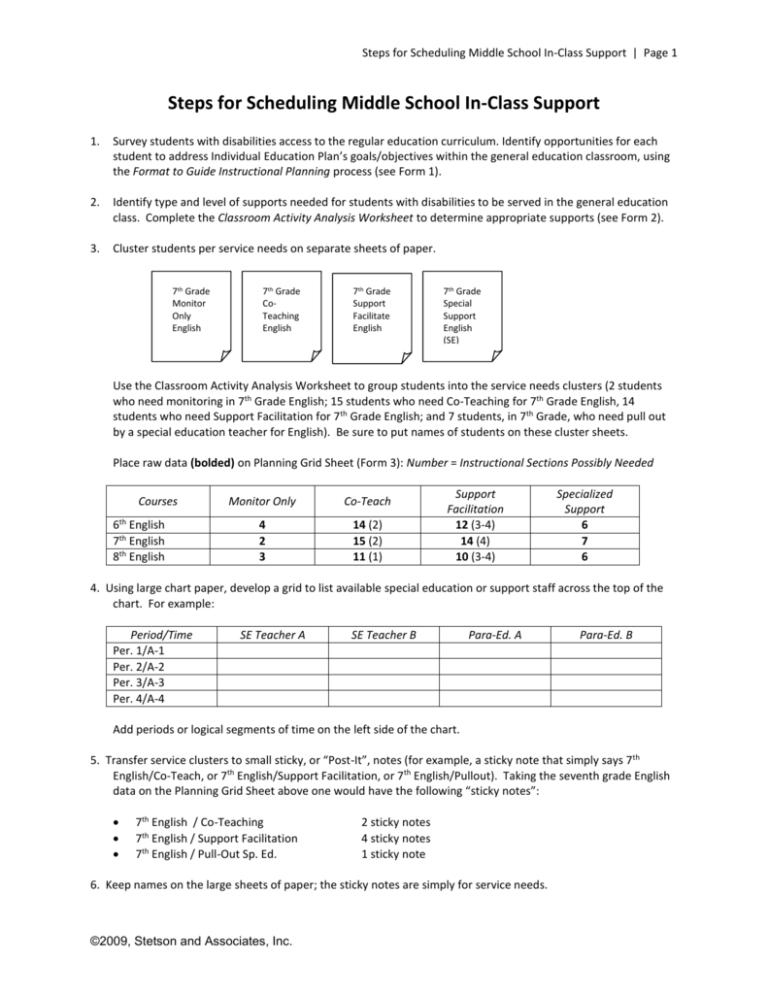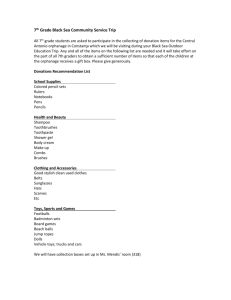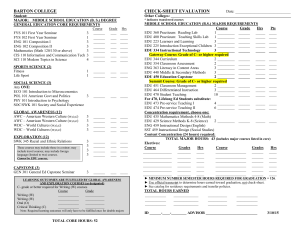Steps for Scheduling In
advertisement

Steps for Scheduling Middle School In-Class Support | Page 1 Steps for Scheduling Middle School In-Class Support 1. Survey students with disabilities access to the regular education curriculum. Identify opportunities for each student to address Individual Education Plan’s goals/objectives within the general education classroom, using the Format to Guide Instructional Planning process (see Form 1). 2. Identify type and level of supports needed for students with disabilities to be served in the general education class. Complete the Classroom Activity Analysis Worksheet to determine appropriate supports (see Form 2). 3. Cluster students per service needs on separate sheets of paper. 7th Grade Monitor Only English 7th Grade CoTeaching English 7th Grade Support Facilitate English 7th Grade Special Support English (SE) Use the Classroom Activity Analysis Worksheet to group students into the service needs clusters (2 students who need monitoring in 7th Grade English; 15 students who need Co-Teaching for 7th Grade English, 14 students who need Support Facilitation for 7th Grade English; and 7 students, in 7th Grade, who need pull out by a special education teacher for English). Be sure to put names of students on these cluster sheets. Place raw data (bolded) on Planning Grid Sheet (Form 3): Number = Instructional Sections Possibly Needed Courses 6th English 7th English 8th English Monitor Only Co-Teach 4 2 3 14 (2) 15 (2) 11 (1) Support Facilitation 12 (3-4) 14 (4) 10 (3-4) Specialized Support 6 7 6 4. Using large chart paper, develop a grid to list available special education or support staff across the top of the chart. For example: Period/Time Per. 1/A-1 Per. 2/A-2 Per. 3/A-3 Per. 4/A-4 SE Teacher A SE Teacher B Para-Ed. A Para-Ed. B Add periods or logical segments of time on the left side of the chart. 5. Transfer service clusters to small sticky, or “Post-It”, notes (for example, a sticky note that simply says 7 th English/Co-Teach, or 7th English/Support Facilitation, or 7th English/Pullout). Taking the seventh grade English data on the Planning Grid Sheet above one would have the following “sticky notes”: 7th English / Co-Teaching 7th English / Support Facilitation 7th English / Pull-Out Sp. Ed. 2 sticky notes 4 sticky notes 1 sticky note 6. Keep names on the large sheets of paper; the sticky notes are simply for service needs. ©2009, Stetson and Associates, Inc. Steps for Scheduling Middle School In-Class Support | Page 2 7. Begin to fill in the scheduling chart of special education support staff with sticky notes. For example: Period: Sp. Ed. Teacher A Sp. Ed. Teacher B Planning Period 1 7th English Co-Teach Period 2 7th English Co-Teach 6th English Co-Teach Period 3 Spec. Eng. Pull-out 3X-6th Eng/SF 2X-8th Eng/SF Period 4 Planning 6th English Co-Teach Sp. Ed. Para-Ed. A Sp. Ed. Para-Ed. B 2X-7th Eng/SF 2X-7th Eng/SF 1X-8th Eng/SF 2X-6th Eng/SF 2X-6th Eng/SF 1X-8th Eng/SF 2X-7th Eng/SF 2X-7th Eng/SF 1X-7th Eng/SF 3X-6th Eng/SF 2X-6th Eng/SF 3X-8th Eng/SF 2X-6th Eng/SF 3X-8th Eng/SF 2X-8th Eng/SF Spec. Eng. Pull-out Spec. Eng. Pull-out Period 5 Period 6 Period 7 Period 8 Now, match the special education personnel support with a general education teacher’s class at the same period. If the master schedule has not been developed, this signals a need for a general education class of this content at this time period. If the master schedule has been developed, then locate a content class needed and identify the teacher. Special Note: In placing “support facilitation” stickies, it is important to note that you may have more than one sticky in each of the time or period segment (display box) because support facilitation service, by definition, is not a daily process. Some students receiving support facilitation may only have contact with special education personnel once, twice or even three times a week (or over two weeks). You may find it a valuable practice if you place the frequency of support facilitation on the sticky, e.g. by placing 2X in the lower right-hand corner of the sticky to denote twice a week service. This will give you an overview of services for that time or period segment relative to support facilitation. 8. Develop common planning time between general and special education instructional collaborators. Place special education personnel on the core or departmental team of the team with the largest number of students they support. 9. Variations on master schedules, traditional versus blocked versus modified block, can be supported with a few minor modifications with this process. For example, when “blocking” is the schedule used, the charts will reflect A-B Blocking, or Modified Blocking. 10. Fill in chart with service needs (taken from student-centered process, put on paper, and transferred to sticky notes) just like a jigsaw puzzle. This process is about decision-making. Sometimes clusters are readjusted based on re-examined needs, staffing, scheduling, and student success. Finally, success will come more quickly, and with less effort, if the campus completes this process BEFORE developing the school’s master schedule. ©2009, Stetson and Associates, Inc.





